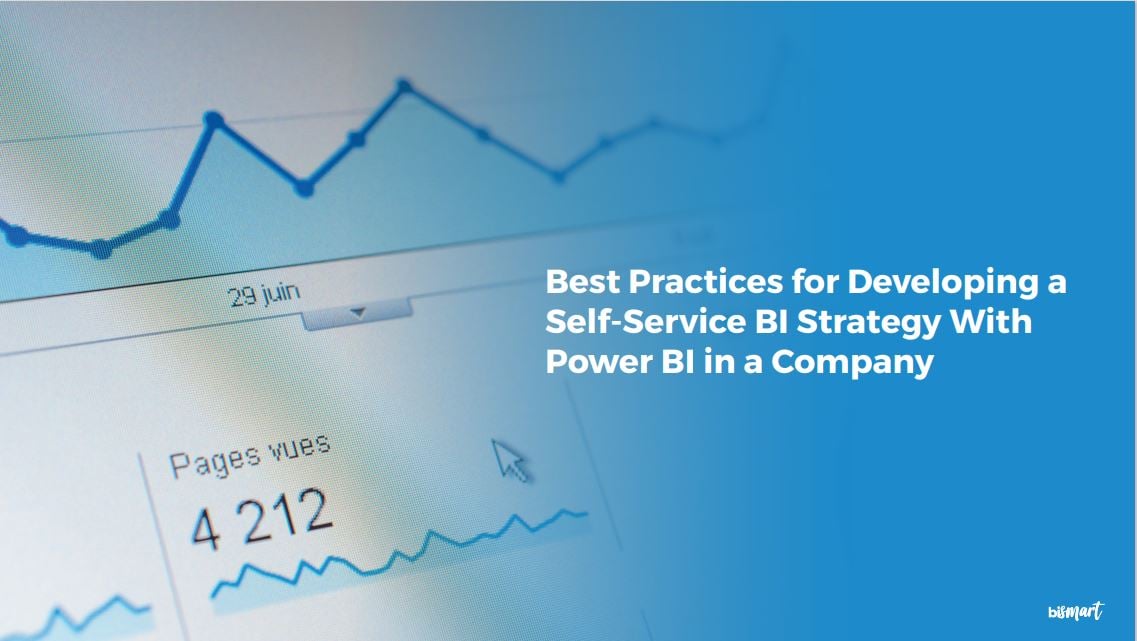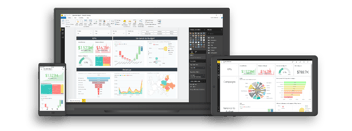What does a company need to develop a self-service BI strategy? Discover what is self-service BI and how to implement a self-service BI model.
More and more companies are adopting self-service BI strategies to meet their analytical, business intelligence and technology exploitation needs. In this article we explore what a self-service BI strategy is and how to implement it successfully in a large company.

As technology deployment in the business environment has expanded, organizations have moved towards the adoption of self-service BI models, which enable them to meet their own analytics and business intelligence needs without resorting to technical experts.
It is now extremely important for companies to understand the concept of self-service BI and its importance to maximize the potential of their data and remain competitive in an increasingly demanding marketplace.
Our team of business intelligence experts has developed a guide with best practices for the development of a self-service BI strategy in a large enterprise.
- Download the e-book "10 best practices for enterprise adoption of a self-service BI model based on Power BI":
What is self-service BI?
Self-service BI is a business information and data exploitation model that has revolutionized the world of business intelligence (BI), allowing anyone to analyze and interpret a company's data without the need to be an IT expert.
Years ago, only users with advanced knowledge of BI tools could take advantage of this type of technology and work with their own data. However, self-service BI allows companies to democratize data analysis by putting the tools needed to understand and analyze data in the hands of any individual.
This new possibility is a game-changer in a context where data has become the basis for data-driven decisions and for assessing and improving our business strategy and actions.
In terms of BI tools, Microsoft Power BI is one of the most widely used business intelligence tools within the business world.
Developing a self-service BI strategy with Microsoft Power BI
Según el último Cuadrante Mágico de Gartner de herramientas analíticas y de business intelligence (ABI) 2023, Microsoft Power BI es la plataforma líder del mercado.
According to the latest Gartner Magic Quadrant for Business Intelligence and Analytics (ABI) 2023, Microsoft Power BI is the leading BI platform of the market.
The great advantage of Microsoft Power BI is that it helps companies transform their data into valuable information and insights through a self-service model. In addition, companies can choose the type of Power BI service or license that best suits their business needs.
In a world where enterprise analytics, business intelligence and data leveraging are in the spotlight, Power BI is positioned as a key tool for businesses that want to leverage technology and data-driven development to their advantage.
On the other hand, the implementation of a data-driven culture is now one of the top priorities in the business world. In order for businesses to transform data into business value through a self-service model, software such as Power BI, which transforms data into easily analyzable information, becomes essential.
At Bismart, as a preferred Microsoft Power BI partner, we have been helping other companies develop a self-service BI strategy by adopting Power BI for many years.
How to develop a self-service BI strategy?
The development of a self-service BI strategy involves much more than the technical construction of reports and requires a complete project that takes into account technical criteria, the health and quality of the organization's data, data security and governance policies, and usage criteria.
On the other hand, it is important for companies to be aware of the two models that exist for the development of a self-service BI strategy.
Models for the development of a self-service BI strategy
1. Internal Experts
This approach applies to companies where most or all users have the technical expertise to create their own reports in BI tools such as Power BI.
The organization outsources the data processing, integration, organization, and preparation of the data sets for later use in Power BI by the company's internal users, who exploit the data and create their own reports with the tool. This approach is ideal for organizations where most users have the ability to build their own reports.
For this model to work, it is necessary to provide professional training to the internal users of the organization so that they can take full advantage of Power BI's capabilities.
At Bismart, we offer a type of training that is ideal for Power BI adoption: We train your internal users using your own datasets, enabling customized training that empowers users to start working with Power BI immediately and with knowledge of the internal content to be exploited.
In addition, this approach also requires the implementation of data governance and security policies. At Bismart, we have two solutions specifically designed to meet the needs of companies working on Power BI with this approach:
-
Power BI Data Catalog: Auto-documents Power BI datasets and complements them with functional and business descriptions, encouraging their correct use and empowering business users to create their own reports without technical assistance.
- Indicators and Dimensions Definition Tool: Environment where users can check the available indicators and dimensions, as well as the metadata, to know which dimensions can they use to analyze each of the indicators in a report.
It is also necessary to assign an administrator or a number of administrators who control data assets and user activity in Power BI. For this purpose, Bismart recommends the implementation of Power BI Analytics:
- Power BI Analytics: Analytical environment where users can analyze all the activity recorded in the Power BI Service of an organization without limits of time, users or workspaces. It automatically records and stores all historical activity in the organization's own data repository.
2. Business Focus
This approach is best suited for companies that have a small BI or IT department that creates the Power BI reports and all other users in the company have a business profile and only act as consumers of the reports. This approach is also appropriate for companies that do not have any users with technical expertise, as they can outsource the entire reporting and report creation process.
- One of the main handicaps of this approach is cost overruns. Most organizations incur unnecessary expenses by purchasing multiple Power BI Pro licenses for each business user who needs to view reports, even though it is not necessary.
On the other hand, this approach requires the development of a large number of policies related to the use and exploitation of datasets, as well as policies for the development of dataflows and policies for the creation and consumption of corporate reports.
Bismart has created Power BI Viewer specifically for the needs of organizations working with this model.
Power BI Viewer allows you to view all of your company's reports from a single, customizable environment with a single Power BI Pro license, resulting in huge cost savings. In addition, the solution is designed for data governance and security.
Risk factors and best practices for developing a self-service BI strategy with Power BI
The exploitation and efficient use of Power BI involves several factors that impact its performance and the generation of business value from it. In addition, the adoption of any technology always poses challenges. Challenges that, if not effectively resolved, can affect long-term business performance and reduce the ROI of Microsoft Power BI.
Beyond the need for technical support from experts in the tool to get it up and running, the success of Power BI adoption also depends, in large part, on the business perspective with which the deployment process is approached.
At Bismart, we always explain to the companies we work with on Power BI projects that the goal of a Power BI implementation process is not to make the tool work. The goal should always be to get Power BI to deliver the expected business results.
The former is easy to achieve and does not require much preparation. Achieving the latter is more complex, but not doing so can be a huge waste of time and money.
At Bismart we understand that Power BI is the instrument, not the goal. When a company decides to invest in the tool, it does so because it expects to improve its business results, to better understand its own business activity, to have a greater capacity to analyze its objectives and performance and/or to solve a series of latent business needs.
The development of a self-service BI model with Power BI ends when all of the above is fulfilled and we have achieved that a company meets the objectives established once the technology is enabled.
Key challenges of developing a self-service BI strategy with Power BI
As with any new technology, the implementation of Power BI in an already consolidated technological ecosystem comes with certain challenges that may condition its future performance.
- Data Incompatibility: Having a proper internal data integration process in place is critical. In order for a company to get the most out of Power BI, it is necessary that the data available to the company is properly integrated and compatible with each other. Incompatibility issues between formats is one of the biggest problems faced by organizations.
- Low quality data: The ultimate goal of acquiring a tool like Power BI is to have an optimal information base and make better business decisions. At Bismart we always say that the quality of your decisions depends on the quality of your data. Ensuring that the data we work with is of optimal quality involves multiple transformation processes that ensure the accuracy, consistency and reliability of the data assets.
- Data model: Another key factor in getting the most out of Power BI is using the right data model. A poorly constructed data model can completely corrupt your pre-design steps and prevent you from transforming data into insights. When using Power BI, it is important for companies to work with simple and properly labeled data models. If these premises are not met, it will be difficult to meet the expectations of users who will work with or visualize the reports and dashboards created with Power BI.
- Data governance: Data governance is another key factor that influences the use of data in convergence with the defined business strategy. As a company grows, so do its data assets. Managing data correctly is important not only to get the most out of it, but also for data compliance issues, to comply with existing regulatory frameworks, to strengthen data security and to reduce the associated risk.
Even Gartner notes that data governance is the weakest point of Power BI. Certainly, for organizations that need multiple users working on the platform, and especially users with different profiles, managing activity, assets and users can be complex.
However, there is a data governance solution specifically for Power BI that is also a great cost saver for companies with multiple Power BI users, as it allows an unlimited number of users to view and share reports with a single Power BI Pro license.
- Lack of technical knowledge to use the tool: Power BI is a fairly intuitive tool. However, designing a data model, processing it and then transforming it into reports, visuals and dashboards requires a certain level of technical knowledge. In fact, the vast majority of users working with Power BI are data analysts or data scientists.
At Bismart, we are committed to a hybrid model that allows companies to get the most out of the tool after adopting Power BI. Not only do we take care of all the processes required to create reports and dashboards in Power BI —from data integration to data visualization— but, after the implementation and preparation of the tool, we provide comprehensive support to ensure that companies achieve the expected results over time and to solve any problems that may arise. On the other hand, our support service is complemented with training services on the tool so that end users are able to use it to its full potential.
How to foster a self-service BI approach with Power BI?
In this article we have listed the most significant risk and success factors when developing a self-service BI model within an organization. However, data-driven technology adoptions are complex and there are other factors that can condition the success of the project.
Discover the steps to follow to develop a self-service BI strategy with Power BI in the e-book "10 best practices for the adoption of a self-service BI model with Power BI":
At Bismart we are experts in the development and implementation of self-service BI models with Power BI projects, offering complete coverage of each and every stage of the project.
We want to help! If you have any questions, need more information about this type of projects or would simply like to tell us something, please do not hesitate to do so



